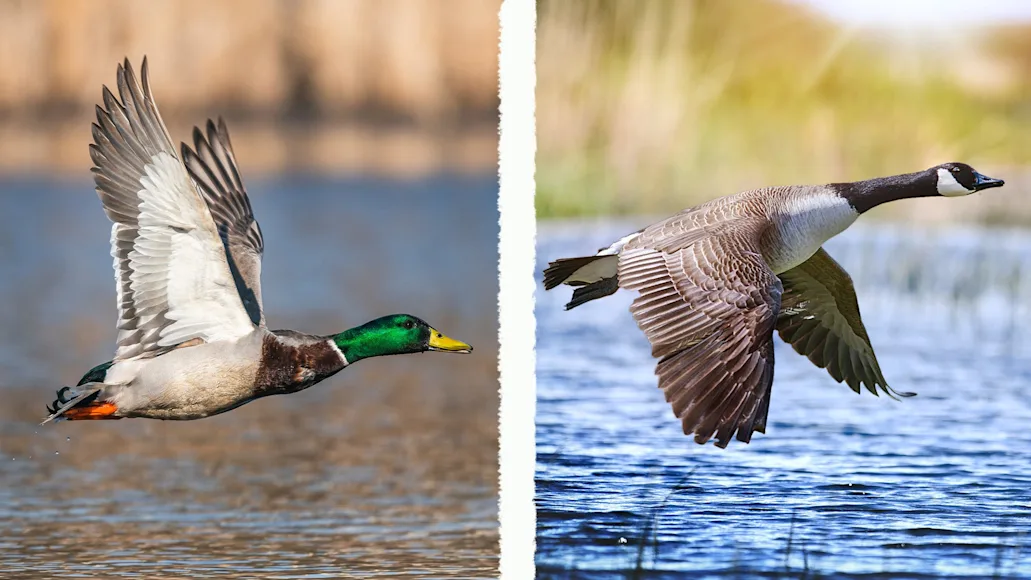_We may earn revenue from the products available on this page and participate in affiliate programs. Learn more ›
_
Ducks and geese share webbed feet, a branch on the avian family tree, and overlapping habits and habitats. Sometimes you will have opportunities to take both ducks and geese on the same hunt, but more often, you’ll be more successful targeting one species or the other. There are differences in hunting methods for ducks and geese. Both ducks and geese have their fans and hunters who specialize in one or the other. A lot of us like hunting both, because duck vs goose hunting is more alike than it is different.
Ducks and Geese
Both ducks and geese belong to the family Anatidae, which also includes swans. Most geese are bigger than most ducks, although some very small geese are no bigger than some large ducks. Geese are almost completely vegetarian, feeding on aquatic plants and often grazing on land. The widespread conversion of America’s grasslands to agriculture turned many geese into grain feeders as well.
Many duck species also feed on aquatic plants and many also include invertebrates in their diet. Some of the dabbling duck species also feed on land. Diving ducks never feed on land, instead preferring both plants and crustaceans, while sea ducks feed on mollusks, crustaceans, small fish and a few plants. In freshwater, the mergansers are adapted to a diet of fish.
Both ducks and geese migrate, although some geese and ducks are hardy enough to winter where they hatched as long as they can find open water and food. And, ducks and geese, as well as swans and sandhill cranes, must all be hunted with non-toxic shot fired from shotguns holding no more than three shells, and being no larger than 10-gauge. Waterfowl season dates are set by individual states according to a federal framework that dictates the number of season days and allowable starting and ending dates. While seasons take place in fall and winter to target birds on their southward migration. There are a few exceptions, most notably the spring snow goose conservation season, which takes place in late winter and spring.
You have to buy both a state and federal migratory bird stamp to hunt ducks or geese. Lead shot is not allowed for hunting either, and your gun must not hold more than three shells in total. Both ducks and geese have sharp color vision, and successful hunters wear camo or drab clothing and make sure they are well-concealed.
Ducks
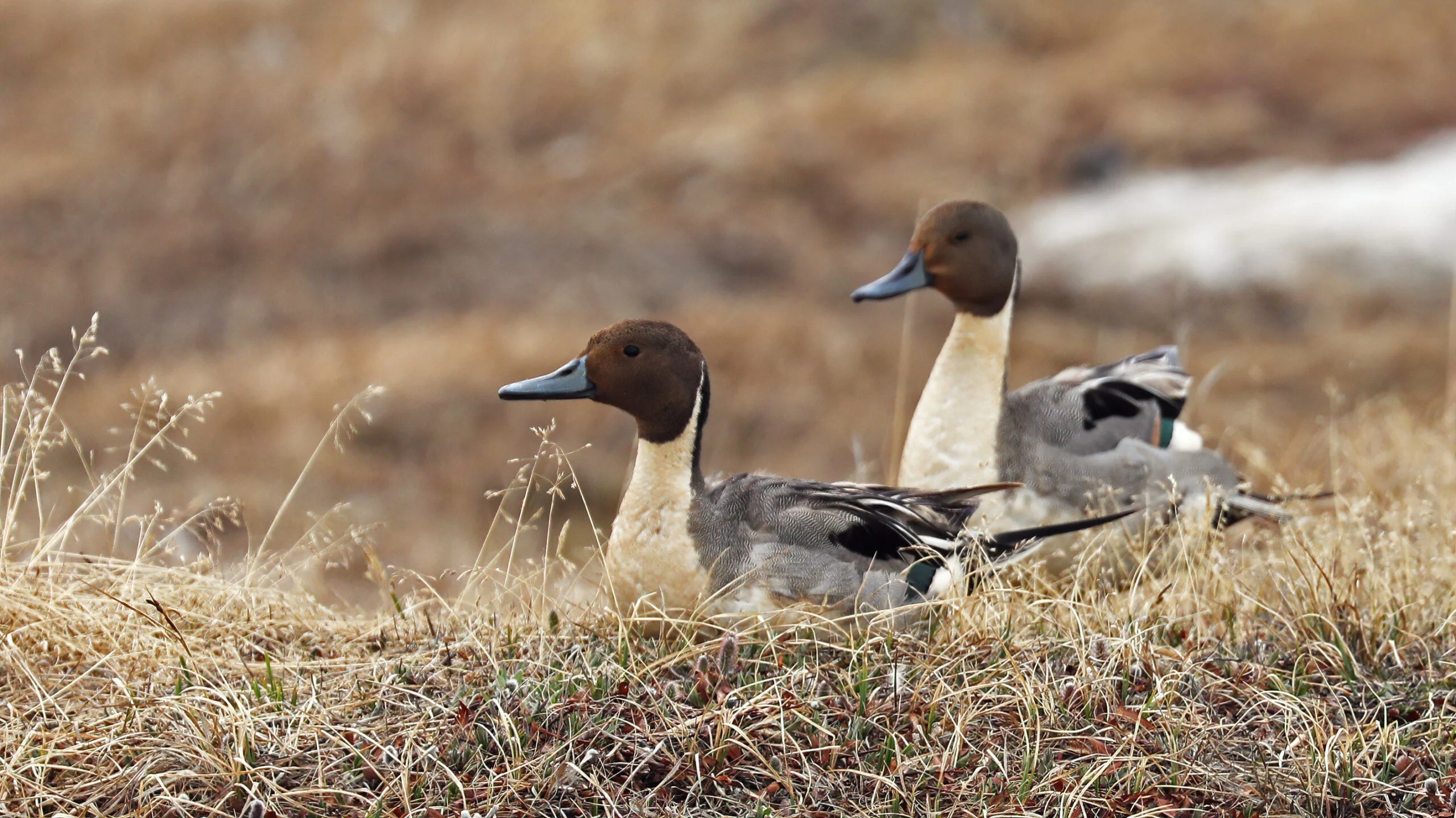
Some duck species, primarily mallards, pintails, and occasionally wood ducks and wigeon, will feed in fields as well. Adobe Stock / Silvio
Including rare species and accidental visitors, there are 47 different duck species recorded in North America. You can divide them into puddle ducks, diving ducks and sea ducks. Also known as dabbling ducks, puddle ducks tip up to feed and usually frequent shallower wetlands. Divers are birds of bigger, deeper water on the whole, and as their name suggests, they dive underwater to find their food. Sea ducks have evolved to live in saltwater. They are champion divers routinely feeding at depths of 30-50 feet and sometimes more.
Geese
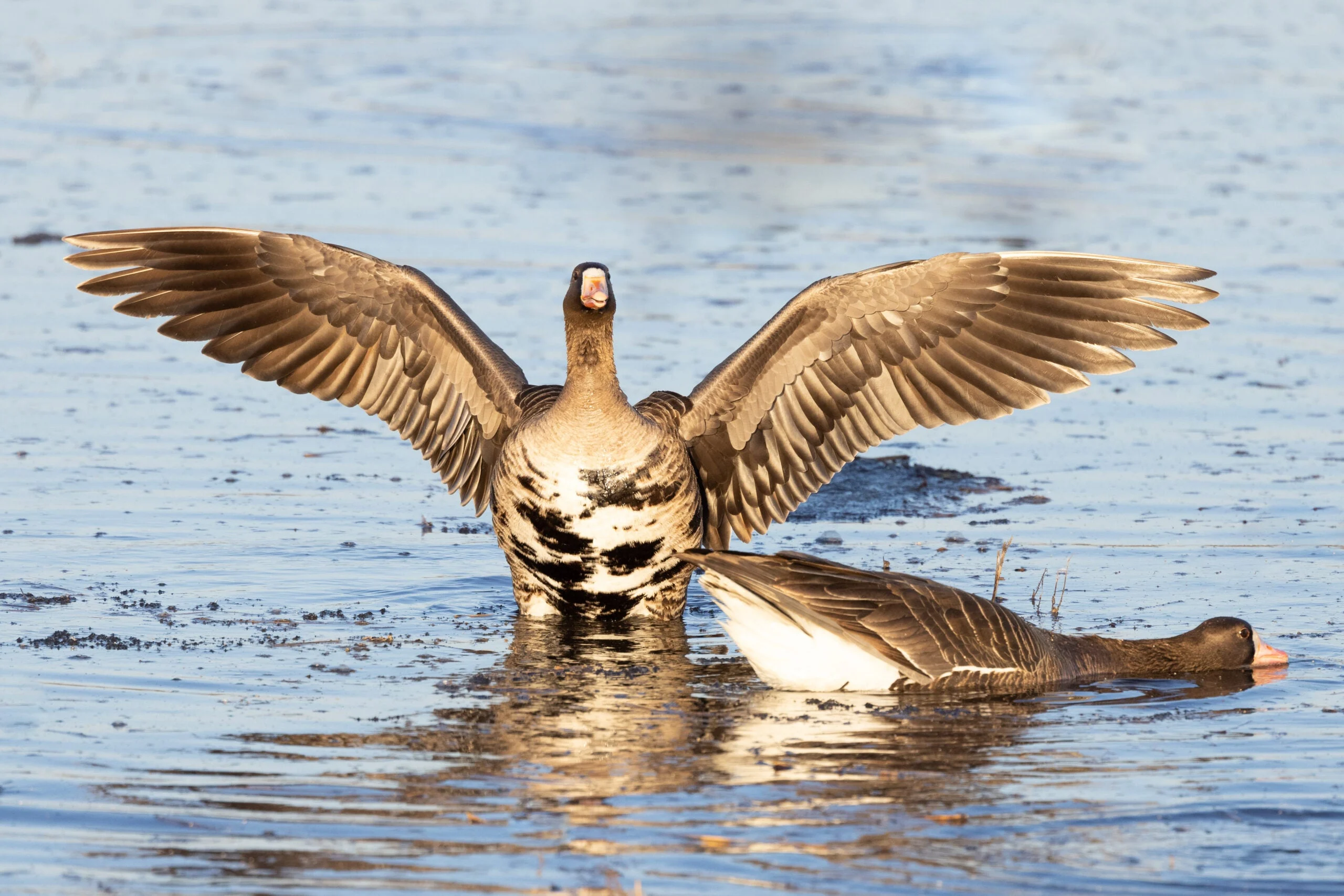
White-fronted geese are primarily found west of the Mississippi. Also called “specklebellies” for the black bars on their breasts, they are becoming more widespread and more popular among hunters. Adobe Stock / Dee Carpenter
North American geese include seven sub-species of Canada, which, collectively as the most common and widespread geese in the U.S. and are a common sight in parks and golf courses as well as in wilder locales. The four subspecies of cackling geese were, until recently, classified as Canadas
but now comprise a separate species. Greater and lesser snow geese breed in the arctic. All greaters and most lessers are white with black wingtips. Blue geese, which are blue-gray with white heads, are a color-phase of lesser snows, and mix in with the white birds. Ross’s geese resemble small snow geese. They are white, and older males grow warty caruncles on their bills. Sometimes they mix with snows, sometimes they fly in flocks of their own.
White-fronted geese are primarily found west of the Mississippi. Also called “specklebellies” for the black bars on their breasts, they are becoming more widespread and more popular among hunters.
Finally, brant are small geese that winter along the East and West Coasts and rarely come inland.
Duck vs Goose Hunting
The biggest difference when it comes to duck vs goose hunting is that most goose hunting takes place on dry land, while most duck hunting occurs over water. That’s not a hard, fast rule. Several species of puddle ducks can be hunted in fields, and geese can be shot over water. It’s sometimes possible to hunt both ducks and geese at the same time, either in fields or on the water. However, the vast majority of goose hunts take place in harvested grain fields. Some duck hunts, do, too, but most hunters set up over water for ducks.
Duck vs Goose Water Hunting
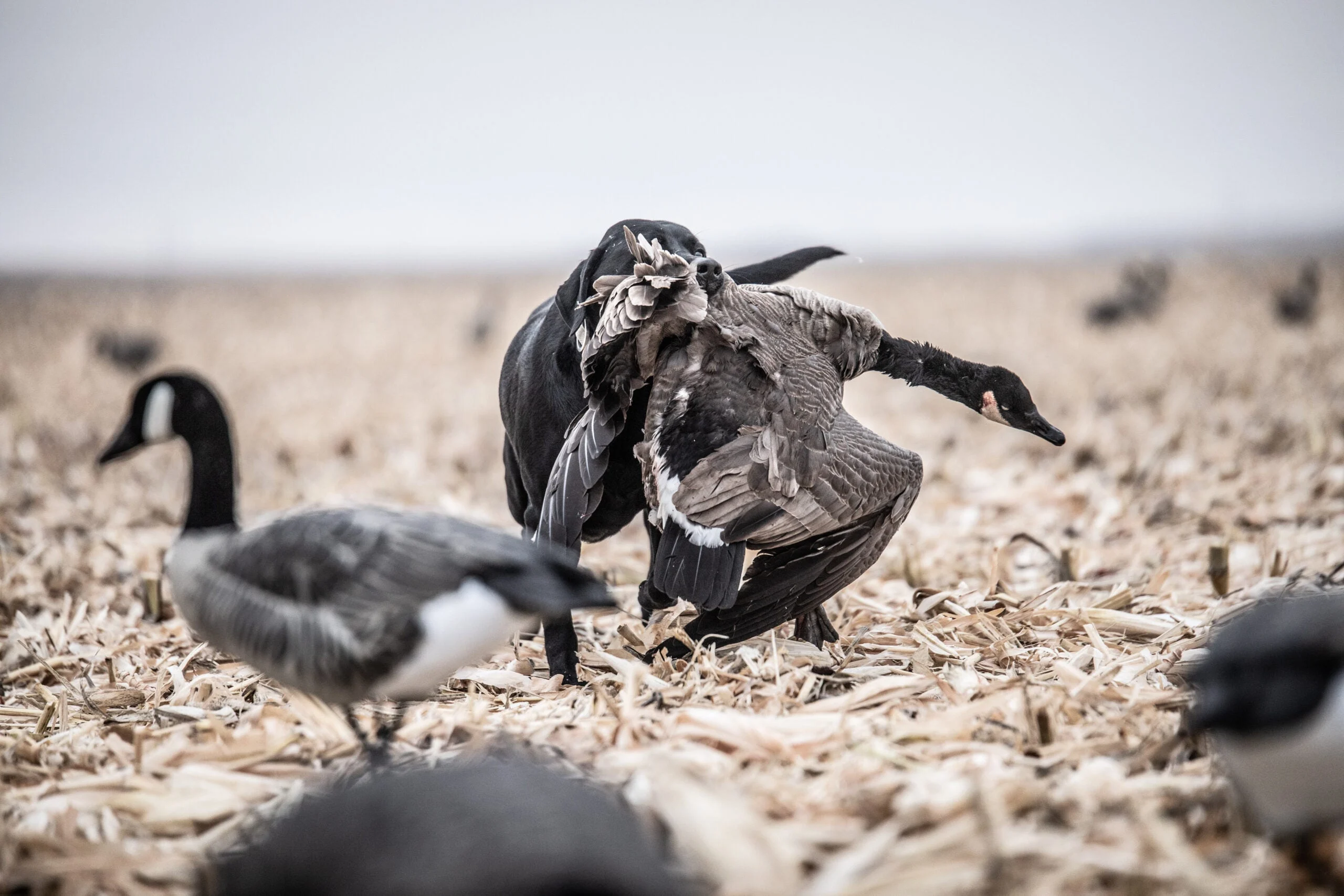
Typically, hunters set duck decoys early in the morning, as that is when the birds are the most active. Adobe Stock / LemieuxImages
All duck and goose species can be hunted over water—marshes, ponds, lakes, and rivers—where ducks feed. They will also loaf during the day and roost at night on water. A decoy spread
can work any time of day so long as you have scouted the area beforehand to know when the birds will be there. Typically, hunters set duck decoys early in the morning, as that is when the birds are the most active.
Geese, on the other hand, typically roost on the water overnight, then fly out to feed in fields in the morning and in the afternoon. Water spreads for geese usually are most effective when you can find a loafing area and set up to hunt it mid-morning to mid-afternoon, to catch birds as they return from the fields looking for a place to sit down. With both ducks and geese, hunting the roost in the late afternoon can be very effective, but it’s frowned upon because disrupting a roost can push birds out of the area.
Field Hunting
All geese, except for brant, can be hunted over dry grain fields, hayfields, and pastures where they come to feed on waste grains or grasses. Some duck species, primarily mallards
, pintails, and occasionally wood ducks and wigeon, will feed in fields as well.
More than any other type of hunting, field hunting demands scouting. You have to set your decoys in the field where the birds are feeding, or in a field on the flight line to the feed field. It’s difficult to pull them off that line into a different field no matter how many decoys you set. Successful goose hunters spend as much time scouting as they do hunting.
Duck vs Goose Pass-and-Jump Shooting
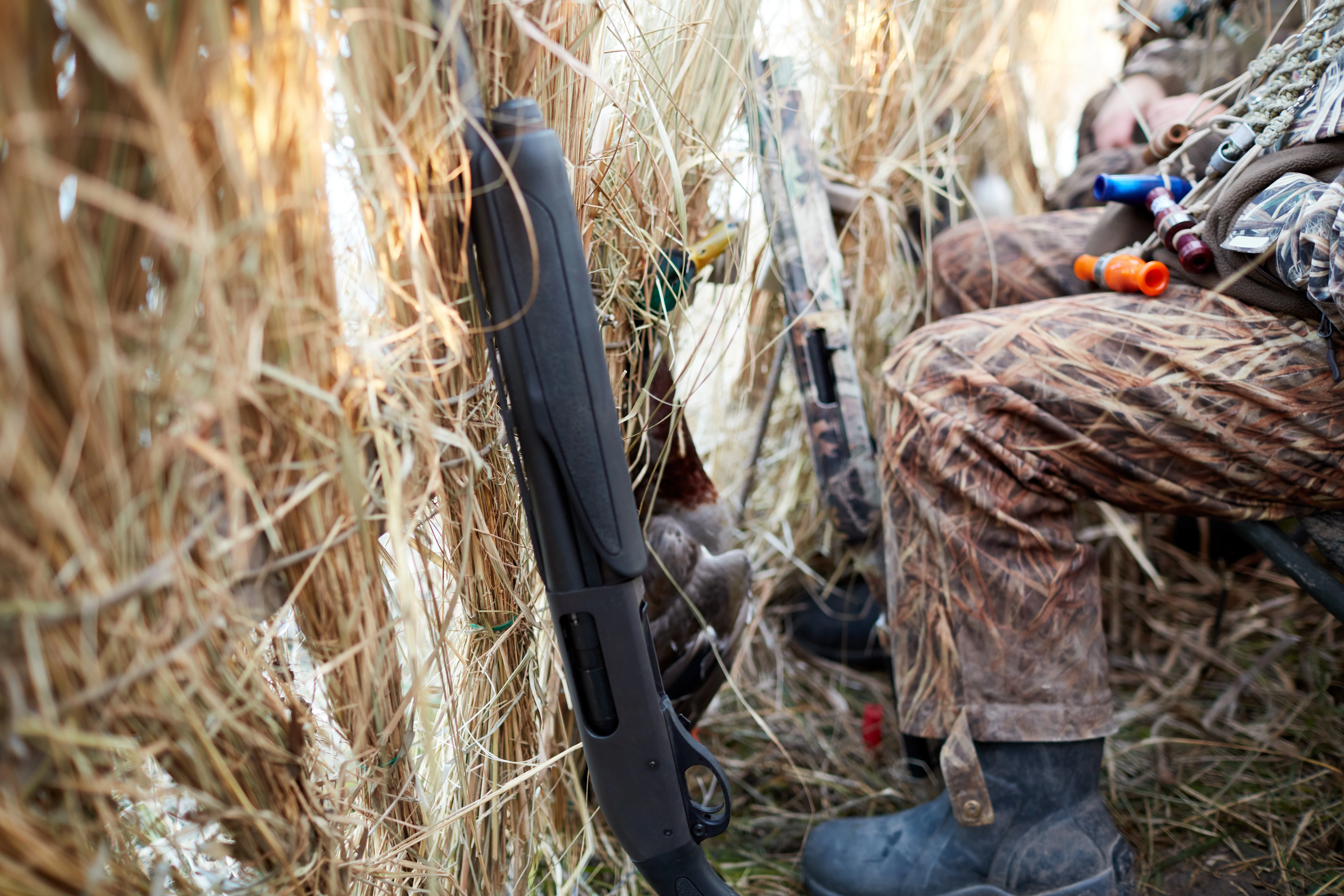
Pass shooting entails learning what routes the birds like to travel, hiding within gun range, and shooting them as they pass by. Adobe Stock / Colby
Two methods that don’t involve decoys can both be effective on ducks and geese. Pass shooting entails learning what routes the birds like to travel, hiding within gun range, and shooting them as they pass by. The difference in duck vs goose pass shooting is that on the whole, pass shooting for ducks takes place near water, as in a neck that connects two marshes, or a levee between ponds. Pass shooting for geese is often a dry-land affair. It used to be very popular around refuges. Now it’s not practiced as much, but if you can find a place geese fly over that puts them in gun range, you can pass-shoot them as they go out to feed or return.
Jump shooting means sneaking up on resting birds, startling them into flight and shooting them on the rise. Jump shooting ducks usually takes place on streams, rivers, or in small wetlands or ponds. Geese can sometimes also be jumped in similar spots, and some people will crawl within range of feeding flocks, especially of snow geese. When it comes to the actual shooting part of jump shooting, puddle ducks can spring up off the water while geese have to labor across the water to get airborne. Jumping puddle ducks can be challenging. Jump shooting geese can sometimes feel too easy, but it can also pay off in a goose dinner.
Duck vs Goose Decoys
As a rule of thumb, you can shoot ducks over goose decoys, but you will rarely shoot geese over duck decoys. Goose decoys are visible from far away, and ducks can feel secure in among geese. That is true in fields and on water. Geese do not like to land with ducks, although sometimes if you have a goose call you can pull them into your duck spread.
Duck vs Goose Motion
Motion in the decoys is very important with both ducks and geese. When hunting over water, anything that makes ripples on a calm day, whether it’s a jerk string or motion decoy. One of the most popular types of motion decoys for ducks is the spinning wing type, while geese will shy away from spinners. The best motion for geese is a goose flag, also called a T-flag, which you wave by hand, and it can be very effective at long distances.
Duck vs Goose Calling
One of the biggest differences when it comes to duck vs goose calling is that all geese are vocal in the air, while most ducks are quiet in the air most of the time. Often, it’s the honking (or barking or yodeling, depending on the species) of a flock in the air that alerts you to the presence of geese. They will approach silently at times, however. How much noise the geese are making can help you figure out how much you need to call. If they are loud, you can usually respond aggressively. If they aren’t making much noise, a few clucks might be a better choice. You can also watch how the flock reacts. Geese will give you plenty of vocal cues, though.
Calling ducks means reading their body language, looking for a turned head or a faltering wingbeat, then focusing on that individual bird. Occasionally you will hear ducks quacking in the air, often lost single birds. With those birds, you can carry on a conversation as you would with geese.
Duck vs Goose Guns and Loads
The smallest geese and the biggest ducks are roughly the same size, so it stands to reason that guns and loads for ducks and geese might differ. In general, you need bigger shot to hit harder and penetrate deeper into bigger birds, while loads of smaller shot give you more pellets in each shell, the better to insure vital hits on smaller birds. With steel shot, most goose hunters chose sizes 2 or larger (1, BB, BBB) while duck hunters prefer 2 or smaller (3,4,5, even 6 and 7 for the smallest ducks). In order to get sufficient pellet counts of large shot, you need a big hull, which means a larger gun. Most goose hunters choose a 12-gauge, and many of them prefer to use 3 1/2-inch shells. Duck hunters also shoot 12-gauges, though the use of 20- and 28-gauges has become a trend in recent years.
Duck vs Goose for Dinner
Finally, there is the taste. Both are delicious when cooked properly, with some caveats. What birds taste like depends on what they have been eating. In general, birds that have been eating grain or vegetation will taste better than those that feed on crustaceans, mollusks and, especially, fish. It’s hard to make a fish-eating duck taste good, and while mollusk-eating sea ducks can be tasty, it takes some work in the kitchen to cook them right. On the other hand, a rice- or corn-fed puddle duck is bound to be delicious.
Geese, which feed primarily on grain, are also very good to eat. Goose can be tougher than duck, so the meat has to be sliced thin or it can be chewy.
Both ducks and geese have dark red breast meat that should be cooked rare and if it doesn’t overcook, it tastes similar to beef. Cooking either too much brings out a liver-taste that most people don’t like. The legs of both ducks and geese can be slow-cooked very successfully. You can also render goose and duck fat for frying potatoes and other things.
Some hunters prefer geese because they yield so much more meat that can be made into jerky or meat sticks. The correct answer to duck vs goose for dinner is both.

